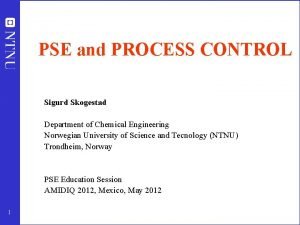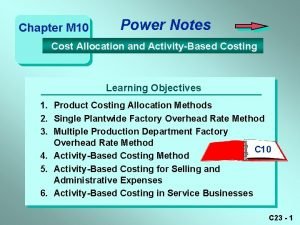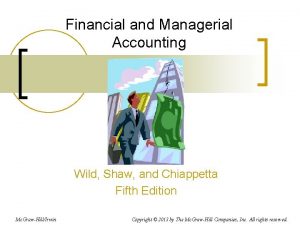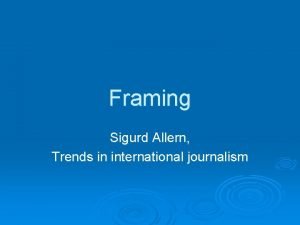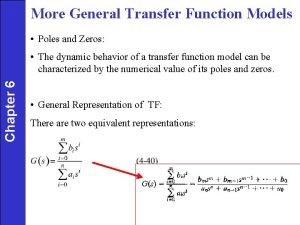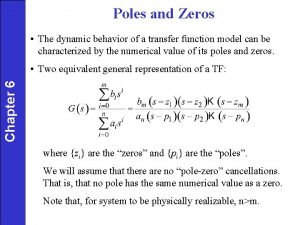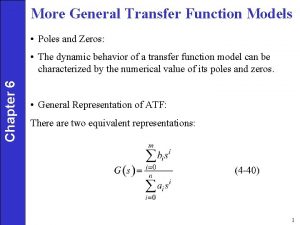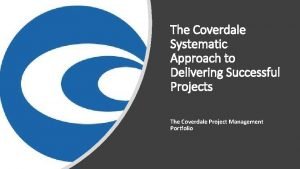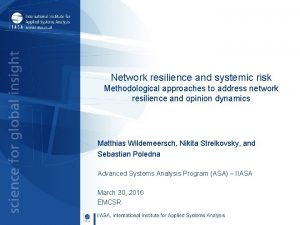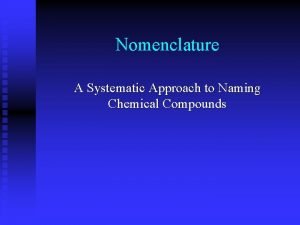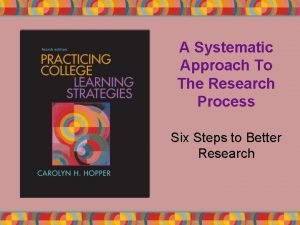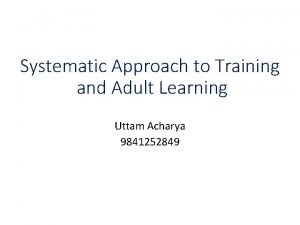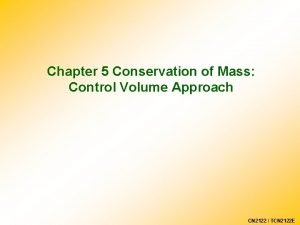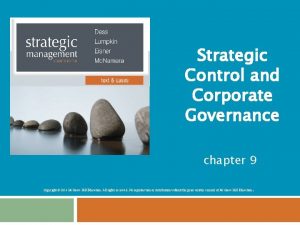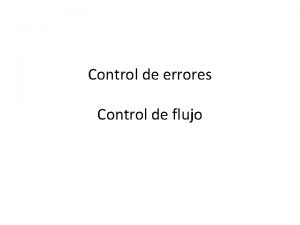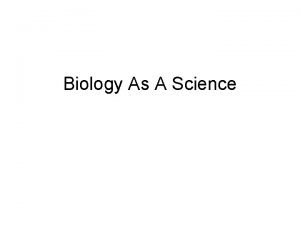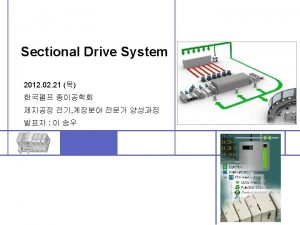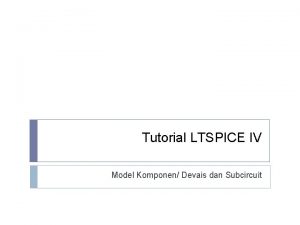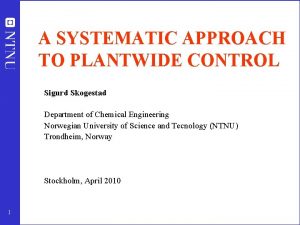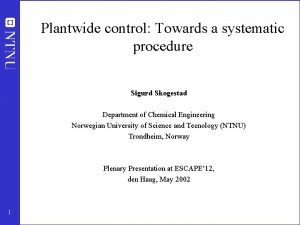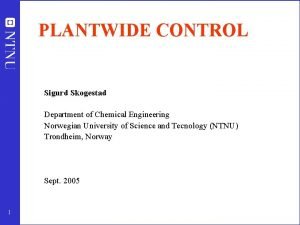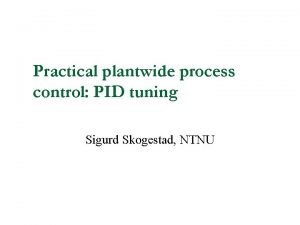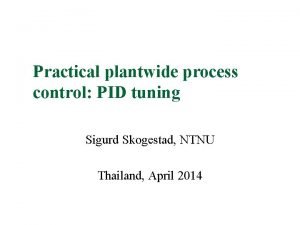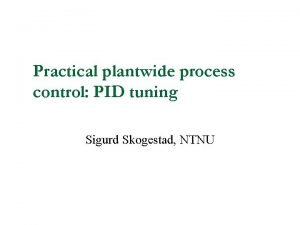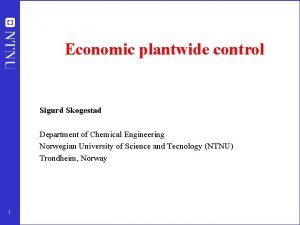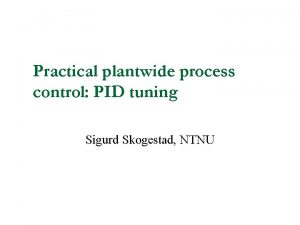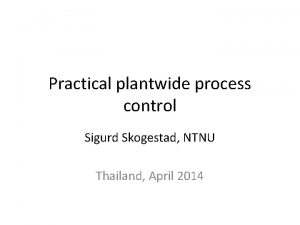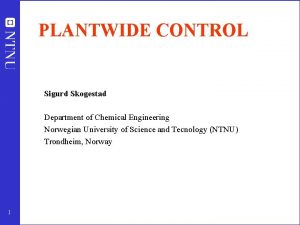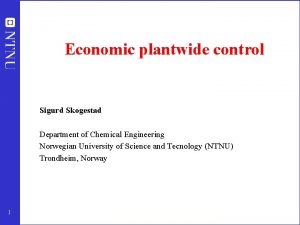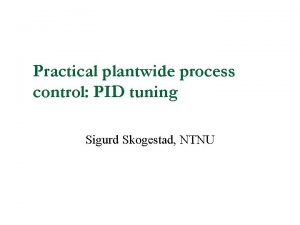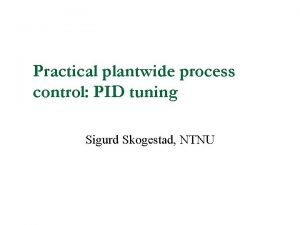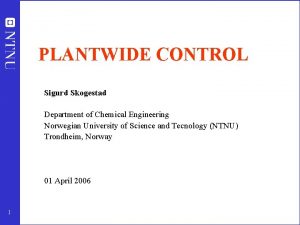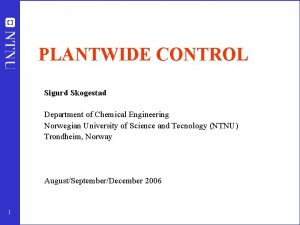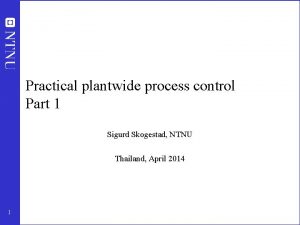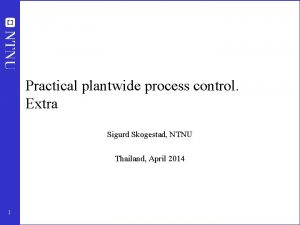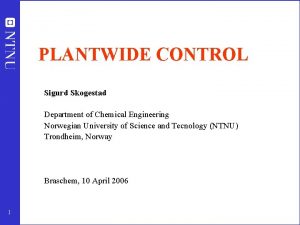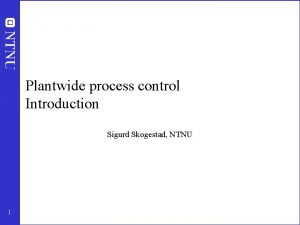A SYSTEMATIC APPROACH TO PLANTWIDE CONTROL Sigurd Skogestad





































- Slides: 37

A SYSTEMATIC APPROACH TO PLANTWIDE CONTROL Sigurd Skogestad Department of Chemical Engineering Norwegian University of Science and Tecnology (NTNU) Trondheim, Norway REACH symposium in honor of Prof. Ananth. IIT Madras, Dec. 2010 1

Trondheim, Norway India Brasil 2

NTNU, Trondheim 3 Northernmost cathedral in the world Northernmost Ch. E Department

4

5

Dealing with complexity Plantwide control The controlled variables (CVs) interconnect the layers OBJECTIVE Min J (economics) RTO cs = y 1 s MPC other variables) y 2 s PID 6 Follow path (+ look after Stabilize + avoid drift u (valves)

How we design a control system for a complete chemical plant? • • 7 Where do we start? What should we control? and why? etc.

• Alan Foss (“Critique of chemical process control theory”, AICh. E Journal, 1973): The central issue to be resolved. . . is the determination of control system structure. Which variables should be measured, which inputs should be manipulated and which links should be made between the two sets? There is more than a suspicion that the work of a genius is needed here, for without it the control configuration problem will likely remain in a primitive, hazily stated and wholly unmanageable form. The gap is present indeed, but contrary to the views of many, it is theoretician who must close it. Previous work on plantwide control: 8 • Page Buckley (1964) - Chapter on “Overall process control” (still industrial practice) • Greg Shinskey (1967) – process control systems • Alan Foss (1973) - control system structure • Bill Luyben et al. (1975 - ) – case studies ; “snowball effect” • George Stephanopoulos and Manfred Morari (1980) – synthesis of control structures for chemical processes • Ruel Shinnar (1981 - ) - “dominant variables” • Jim Downs (1991) - Tennessee Eastman challenge problem • Larsson and Skogestad (2000): Review of plantwide control

Control structure design procedure I Top Down • Step 1: Define operational objectives (optimal operation) – Cost function J (to be minimized) – Operational constraints • Step 2: Identify degrees of freedom (MVs) and optimize for expected disturbances • Step 3: Select primary controlled variables c=y 1 (CVs) • Step 4: Where set the production rate? (Inventory control) II Bottom Up • Step 5: Regulatory / stabilizing control (PID layer) – What more to control (y 2; local CVs)? – Pairing of inputs and outputs • Step 6: Supervisory control (MPC layer) • Step 7: Real-time optimization (Do we need it? ) 9 y 1 y 2 MVs Process

Step 1. Define optimal operation (economics) • • What are we going to use our degrees of freedom u (MVs) for? Define scalar cost function J(u, x, d) – u: degrees of freedom (usually steady-state) – d: disturbances – x: states (internal variables) Typical cost function: J = cost feed + cost energy – value products • Optimize operation with respect to u for given d (usually steady-state): minu J(u, x, d) subject to: Model equations: f(u, x, d) = 0 Operational constraints: g(u, x, d) < 0 10

Step 2: Identify degrees of freedom and optimize for expected disturbances • Optimization: Identify regions of active constraints • Time consuming! Control 3 active constraints 1 2 3 11 2 1 3 unconstrained degrees of freedom -> Find 3 CVs

Step 3: Implementation of optimal operation • Optimal operation for given d*: minu J(u, x, d) subject to: Model equations: Operational constraints: → uopt(d*) f(u, x, d) = 0 g(u, x, d) < 0 Problem: Usally cannot keep uopt constant because disturbances d change How should we adjust the degrees of freedom (u)? 12

Implementation (in practice): Local feedback control! y “Self-optimizing control: ” Constant setpoints for c gives acceptable loss d 13 Local feedback: Control c (CV) Optimizing control Feedforward

Question: What should we control (c)? (primary controlled variables y 1=c) Issue: What should we control? • Introductory example: Runner 14

Optimal operation - Runner Optimal operation of runner – Cost to be minimized, J=T – One degree of freedom (u=power) – What should we control? 15

Optimal operation - Runner Sprinter (100 m) • 1. Optimal operation of Sprinter, J=T – Active constraint control: • Maximum speed (”no thinking required”) 16

Optimal operation - Runner Marathon (40 km) • 2. Optimal operation of Marathon runner, J=T • Unconstrained optimum! • Any ”self-optimizing” variable c (to control at constant setpoint)? • • 17 c 1 = distance to leader of race c 2 = speed c 3 = heart rate c 4 = level of lactate in muscles

Optimal operation - Runner Conclusion Marathon runner select one measurement c = heart rate 18 • Simple and robust implementation • Disturbances are indirectly handled by keeping a constant heart rate • May have infrequent adjustment of setpoint (heart rate)

Step 3. What should we control (c)? (primary controlled variables y 1=c) Selection of controlled variables c 1. Control active constraints! 2. Unconstrained variables: Control self-optimizing variables! 19

Unconstrained degrees of freedom Control “self-optimizing” variables 1. Old idea (Morari et al. , 1980): “We want to find a function c of the process variables which when held constant, leads automatically to the optimal adjustments of the manipulated variables, and with it, the optimal operating conditions. ” 2. The ideal self-optimizing variable c is the gradient (c = J/ u = Ju) – Keep gradient at zero for all disturbances (c = Ju=0) – Problem: no measurement of gradient cost J 20 u

H 21

H 22

Guidelines for selecting single measurements as CVs • Rule 1: The optimal value for CV (c=Hy) should be insensitive to disturbances d (minimizes effect of setpoint error) • Rule 2: c should be easy to measure and control (small implementation error n) • Rule 3: “Maximum gain rule”: c should be sensitive to changes in u (large gain |G| from u to c) or equivalently the optimum Jopt should be flat with respect to c (minimizes effect of implementation error n) 23 Reference: S. Skogestad, “Plantwide control: The search for the self-optimizing control structure”, Journal of Process Control, 10, 487 -507 (2000).

Optimal measurement combination • Candidate measurements (y): Include also inputs u H 24

No measurement noise Nullspace method 25

With measurement noise Optimal measurement combination, c = Hy cs = constant + - K u + + c + y + H “=0” in nullspace method (no noise) “Minimize” in Maximum gain rule ( maximize S 1 G Juu-1/2 , G=HGy ) 26 “Scaling” S 1

Example: CO 2 refrigeration cycle J = W s (work supplied) DOF = u (valve opening, z) Main disturbances: d 1 = T H d 2 = T Cs (setpoint) d 3 = UA loss What should we control? 27 p. H

CO 2 refrigeration cycle Step 1. One (remaining) degree of freedom (u=z) Step 2. Objective function. J = Ws (compressor work) Step 3. Optimize operation for disturbances (d 1=TC, d 2=TH, d 3=UA) • Optimum always unconstrained Step 4. Implementation of optimal operation • No good single measurements (all give large losses): – ph, Th, z, … • Nullspace method: Need to combine nu+nd=1+3=4 measurements to have zero disturbance loss • Simpler: Try combining two measurements. Exact local method: – c = h 1 ph + h 2 Th = ph + k Th; k = -8. 53 bar/K • Nonlinear evaluation of loss: OK! 28

CO 2 cycle: Maximum gain rule 29

Refrigeration cycle: Proposed control structure 30 Control c= “temperature-corrected high pressure”

Step 4. Where set production rate? • • • 31 Where locale the TPM (throughput manipulator)? Very important! Determines structure of remaining inventory (level) control system Set production rate at (dynamic) bottleneck Link between Top-down and Bottom-up parts

Step 5: Regulatory control layer Step 5. Choose structure of regulatory (stabilizing) layer (a) Identify “stabilizing” CV 2 s (levels, pressures, reactor temperature, one temperature in each column, etc. ). In addition, active constraints (CV 1) that require tight control (small backoff) may be assigned to the regulatory layer. (Comment: usually not necessary with tight control of unconstrained CVs because optimum is usually relatively flat) (b) Identify pairings (MVs to be used to control CV 2), taking into account – Want “local consistency” for the inventory control – Want tight control of important active constraints – Avoid MVs that may saturate in the regulatory layer, because this would require either • reassigning the regulatory loop (complication penalty), or • requiring back-off for the MV variable (economic penalty) Preferably, the same regulatory layer should be used for all operating regions without the need for reassigning inputs or outputs. 32

Why simplified configurations? Why control layers? Why not one “big” multivariable controller? • Fundamental: Save on modelling effort • Other: – – – 33 easy to understand easy to tune and retune insensitive to model uncertainty possible to design for failure tolerance fewer links reduced computation load

”Advanced control” STEP 6. SUPERVISORY LAYER Objectives of supervisory layer: 1. Switch control structures (CV 1) depending on operating region • • Active constraints self-optimizing variables 2. Perform “advanced” economic/coordination control tasks. – Control primary variables CV 1 at setpoint using as degrees of freedom (MV): • • – Keep an eye on stabilizing layer • – 34 Avoid saturation in stabilizing layer Feedforward from disturbances • – – Setpoints to the regulatory layer (CV 2 s) ”unused” degrees of freedom (valves) If helpful Make use of extra inputs Make use of extra measurements Implementation: • Alternative 1: Advanced control based on ”simple elements” • Alternative 2: MPC

Summary. Systematic procedure for plantwide control 1. Start “top-down” with economics: – – – 2. Step 1: Define operational objectives and identify degrees of freeedom Step 2: Optimize steady-state operation. Step 3 A: Identify active constraints = primary CVs c. Should controlled to maximize profit) Step 3 B: For remaining unconstrained degrees of freedom: Select CVs c based on self-optimizing control. Step 4: Where to set the throughput (usually: feed) Regulatory control I: Decide on how to move mass through the plant: • 3. Regulatory control II: “Bottom-up” stabilization of the plant • 4. Step 5 B: Control variables to stop “drift” (sensitive temperatures, pressures, . . ) – Pair variables to avoid interaction and saturation Finally: make link between “top-down” and “bottom up”. • Step 6: “Advanced control” system (MPC): • • • 35 Step 5 A: Propose “local-consistent” inventory (level) control structure. CVs: Active constraints and self-optimizing economic variables + look after variables in layer below (e. g. , avoid saturation) MVs: Setpoints to regulatory control layer. Coordinates within units and possibly between units cs

Summary and references • The following paper summarizes the procedure: – S. Skogestad, ``Control structure design for complete chemical plants'', Computers and Chemical Engineering, 28 (1 -2), 219 -234 (2004). • There are many approaches to plantwide control as discussed in the following review paper: – T. Larsson and S. Skogestad, ``Plantwide control: A review and a new design procedure'' Modeling, Identification and Control, 21, 209 -240 (2000). 36

• • • • • • 37 • • S. Skogestad ``Plantwide control: the search for the self-optimizing control structure'', J. Proc. Control, 10, 487 -507 (2000). S. Skogestad, ``Self-optimizing control: the missing link between steady-state optimization and control'', Comp. Chem. Engng. , 24, 569575 (2000). I. J. Halvorsen, M. Serra and S. Skogestad, ``Evaluation of self-optimising control structures for an integrated Petlyuk distillation column'', Hung. J. of Ind. Chem. , 28, 11 -15 (2000). T. Larsson, K. Hestetun, E. Hovland, and S. Skogestad, ``Self-Optimizing Control of a Large-Scale Plant: The Tennessee Eastman Process'', Ind. Eng. Chem. Res. , 40 (22), 4889 -4901 (2001). K. L. Wu, C. C. Yu, W. L. Luyben and S. Skogestad, ``Reactor/separator processes with recycles-2. Design for composition control'', Comp. Chem. Engng. , 27 (3), 401 -421 (2003). T. Larsson, M. S. Govatsmark, S. Skogestad, and C. C. Yu, ``Control structure selection for reactor, separator and recycle processes'', Ind. Eng. Chem. Res. , 42 (6), 1225 -1234 (2003). A. Faanes and S. Skogestad, ``Buffer Tank Design for Acceptable Control Performance'', Ind. Eng. Chem. Res. , 42 (10), 2198 -2208 (2003). I. J. Halvorsen, S. Skogestad, J. C. Morud and V. Alstad, ``Optimal selection of controlled variables'', Ind. Eng. Chem. Res. , 42 (14), 3273 -3284 (2003). A. Faanes and S. Skogestad, ``p. H-neutralization: integrated process and control design'', Computers and Chemical Engineering, 28 (8), 1475 -1487 (2004). S. Skogestad, ``Near-optimal operation by self-optimizing control: From process control to marathon running and business systems'', Computers and Chemical Engineering, 29 (1), 127 -137 (2004). E. S. Hori, S. Skogestad and V. Alstad, ``Perfect steady-state indirect control'', Ind. Eng. Chem. Res, 44 (4), 863 -867 (2005). M. S. Govatsmark and S. Skogestad, ``Selection of controlled variables and robust setpoints'', Ind. Eng. Chem. Res, 44 (7), 2207 -2217 (2005). V. Alstad and S. Skogestad, ``Null Space Method for Selecting Optimal Measurement Combinations as Controlled Variables'', Ind. Eng. Chem. Res, 46 (3), 846 -853 (2007). S. Skogestad, ``The dos and don'ts of distillation columns control'', Chemical Engineering Research and Design (Trans IChem. E, Part A), 85 (A 1), 13 -23 (2007). E. S. Hori and S. Skogestad, ``Selection of control structure and temperature location for two-product distillation columns'', Chemical Engineering Research and Design (Trans IChem. E, Part A), 85 (A 3), 293 -306 (2007). A. C. B. Araujo, M. Govatsmark and S. Skogestad, ``Application of plantwide control to the HDA process. I Steady-state and selfoptimizing control'', Control Engineering Practice, 15, 1222 -1237 (2007). A. C. B. Araujo, E. S. Hori and S. Skogestad, ``Application of plantwide control to the HDA process. Part II Regulatory control'', Ind. Eng. Chem. Res, 46 (15), 5159 -5174 (2007). V. Kariwala, S. Skogestad and J. F. Forbes, ``Reply to ``Further Theoretical results on Relative Gain Array for Norn-Bounded Uncertain systems''''Ind. Eng. Chem. Res, 46 (24), 8290 (2007). V. Lersbamrungsuk, T. Srinophakun, S. Narasimhan and S. Skogestad, ``Control structure design for optimal operation of heat exchanger networks'', AICh. E J. , 54 (1), 150 -162 (2008). DOI 10. 1002/aic. 11366 T. Lid and S. Skogestad, ``Scaled steady state models for effective on-line applications'', Computers and Chemical Engineering, 32, 990 -999 (2008). T. Lid and S. Skogestad, ``Data reconciliation and optimal operation of a catalytic naphtha reformer'', Journal of Process Control, 18, 320 -331 (2008). E. M. B. Aske, S. Strand S. Skogestad, ``Coordinator MPC for maximizing plant throughput'', Computers and Chemical Engineering, 32, 195 -204 (2008). A. Araujo and S. Skogestad, ``Control structure design for the ammonia synthesis process'', Computers and Chemical Engineering, 32 (12), 2920 -2932 (2008). E. S. Hori and S. Skogestad, ``Selection of controlled variables: Maximum gain rule and combination of measurements'', Ind. Eng. Chem. Res, 47 (23), 9465 -9471 (2008). V. Alstad, S. Skogestad and E. S. Hori, ``Optimal measurement combinations as controlled variables'', Journal of Process Control, 19, 138 -148 (2009) E. M. B. Aske and S. Skogestad, ``Consistent inventory control'', Ind. Eng. Chem. Res, 48 (44), 10892 -10902 (2009).
 Pse p&id
Pse p&id How to find plantwide overhead rate
How to find plantwide overhead rate Plantwide overhead rate method
Plantwide overhead rate method Sigurd allern
Sigurd allern Sigurd meldal
Sigurd meldal Sigurd allern
Sigurd allern General transfer function
General transfer function Skogestad half rule
Skogestad half rule Skogestad half rule
Skogestad half rule Coverdale's 'systematic approach to getting things done
Coverdale's 'systematic approach to getting things done A logical systematic procedure for solving a problem
A logical systematic procedure for solving a problem Network resilience a systematic approach
Network resilience a systematic approach Hcn binary or ternary
Hcn binary or ternary Systematic approach to research
Systematic approach to research For adult
For adult Origins of vc and datagram networks
Origins of vc and datagram networks Cognitive approach vs behavioral approach
Cognitive approach vs behavioral approach Waterfall vs shower approach
Waterfall vs shower approach Approach approach conflict
Approach approach conflict Cognitive approach vs behavioral approach
Cognitive approach vs behavioral approach Approach research meaning
Approach research meaning Diagram for traditional approach
Diagram for traditional approach Tony wagner's seven survival skills
Tony wagner's seven survival skills Control volume approach
Control volume approach Strategic control
Strategic control Primary control vs secondary control
Primary control vs secondary control Process control and product control
Process control and product control Control volume vs control surface
Control volume vs control surface Stock control e flow control
Stock control e flow control Control volume vs control surface
Control volume vs control surface What is negative control
What is negative control Positive and negative controls
Positive and negative controls Data link control
Data link control Control de flujo parada y espera
Control de flujo parada y espera Negative control vs positive control examples
Negative control vs positive control examples Error control and flow control
Error control and flow control Sectional drive
Sectional drive Komponen pada ltspice
Komponen pada ltspice
